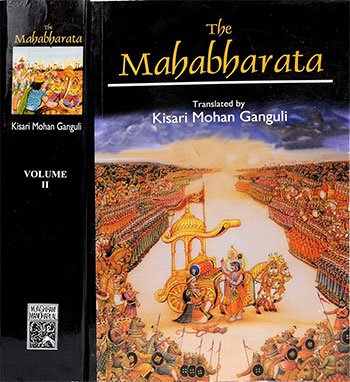Section LV - Arjuna's Fierce Battle: Destruction of Enemy Forces by Pandava Prince
Book index: Mahabharata (English)
This page contains a summary of the Mahabharata Section LV including examples of moral lessons in daily life. The Maha-Bharata is one of the largest epics ever written containing roughly 100,000 Sanskrit verses. It deals with the legendary history of ancient India and contains a large number of interwoven tales.
Short summary of the chapter:
The battle between the Pandavas and Kauravas raged on with Dhrishtadyumna of Pancala engaging in combat with Drona's son, Salya, and Kripa. Dhrishtadyumna managed to slay Drona's son's horses, forcing him to switch to Salya's chariot. Subhadra's son, Abhimanyu, entered the battle and clashed with his cousin Lakshmana, exchanging powerful arrow shots. Infuriated by his son's plight, Duryodhana joined the fight, and other kings surrounded Abhimanyu, prompting Arjuna to come to his son's aid.
The battle escalated as Bhishma and Drona's forces charged at Arjuna, resulting in chaos and turmoil on the battlefield. Arjuna's arrows caused devastation among the enemy ranks, leaving elephants without their riders and warriors losing their weapons. The Kuru army faced a fierce onslaught from Arjuna, with many soldiers fleeing in fear as their leaders fell one by one. Arjuna's onslaught was so intense that the sky darkened from the dust raised by the conflict, and the battlefield was littered with broken weapons and fallen warriors.
Arjuna's prowess in battle was unmatched, as he single-handedly overwhelmed the enemy forces, causing a mass retreat. Devavrata, observing the chaos, acknowledged Arjuna's unstoppable might and advised a strategic withdrawal of the Kaurava army. As dusk fell, both armies disengaged, with Bhishma ordering the retreat of the Kaurava forces due to their exhaustion and inability to rally. The sun set on a day of fierce combat, with both sides regrouping to prepare for the battles ahead in the ongoing war.
Full English translation:
This page is merely a summary which is automatically generated. If you are looking for authentic sources such as the Sanskrit text or the Full English translation of Mahabharata Section LV - Arjuna's Fierce Battle: Destruction of Enemy Forces by Pandava Prince, have a look at the following articles:
Section LV, online text
English translation by Kisari Mohan Ganguli.
Read this and other chapters online.
Mahabharata (English Summary)
by Kisari Mohan Ganguli | ISBN-10: 8121505933
Buy the latest edition:
FAQ of Mahabharata, Section LV:
What happened during the battle between the Pandavas and the Kauravas?
Sanjaya describes the intense battle where Arjuna's son, Abhimanyu, fought bravely. Arjuna's prowess in battle was unmatched, causing chaos and destruction. Eventually, Bhishma ordered the withdrawal of both armies.
Who were the key warriors involved in the battle?
Drona's son, Salya, and Kripa were crucial warriors for the Kauravas. Abhimanyu, Arjuna's son, played a significant role for the Pandavas. Bhishma and Drona led the Kaurava army, while Arjuna and Krishna fought for the Pandavas.
What was the outcome of the battle between the Pandavas and Kauravas?
The Kaurava army was heavily defeated, leading to a chaotic retreat. Arjuna's unmatched prowess on the battlefield caused panic amongst the Kaurava warriors, ultimately resulting in their withdrawal. Bhishma decided to retreat as he saw no hope of victory.
Daily life: Arjuna's Fierce Battle: Destruction of Enemy Forces by Pandava Prince:
The story from the epic Mahabharata, involving intense battle scenes and strategic warfare, can offer profound daily life applications when abstracted to its core themes. At its heart, the narrative emphasizes resilience, adaptability, teamwork, and the importance of wise leadership.
Resilience is key in our daily struggles and challenges, much like the warriors' determination in the face of overwhelming odds. The characters' ability to keep pushing forward, despite setbacks, inspires us to tackle our obstacles with steadfastness and courage. Adaptability is demonstrated through the characters' quick thinking and versatility in combat, reminding us to be flexible and open to change, adjusting our strategies as situations evolve in our personal and professional lives.
Additionally, teamwork and collaboration shine through as essential elements for overcoming adversities. The coalition and support among the warriors, much like Arjuna and Krishna's partnership, underline the strength found in unity. This teaches us the importance of building strong relationships, valuing others' contributions, and working together towards common goals.
Wise leadership, as exemplified by the strategic decisions made during the battle, encourages us to lead with foresight and compassion. Making informed choices, considering the well-being of our team, and guiding them through challenges is vital for achieving success and fostering a positive environment.
By embodying these timeless principles—resilience, adaptability, teamwork, and wise leadership—we can navigate the complexities of daily life more effectively, turning challenges into opportunities for growth and achievement.
